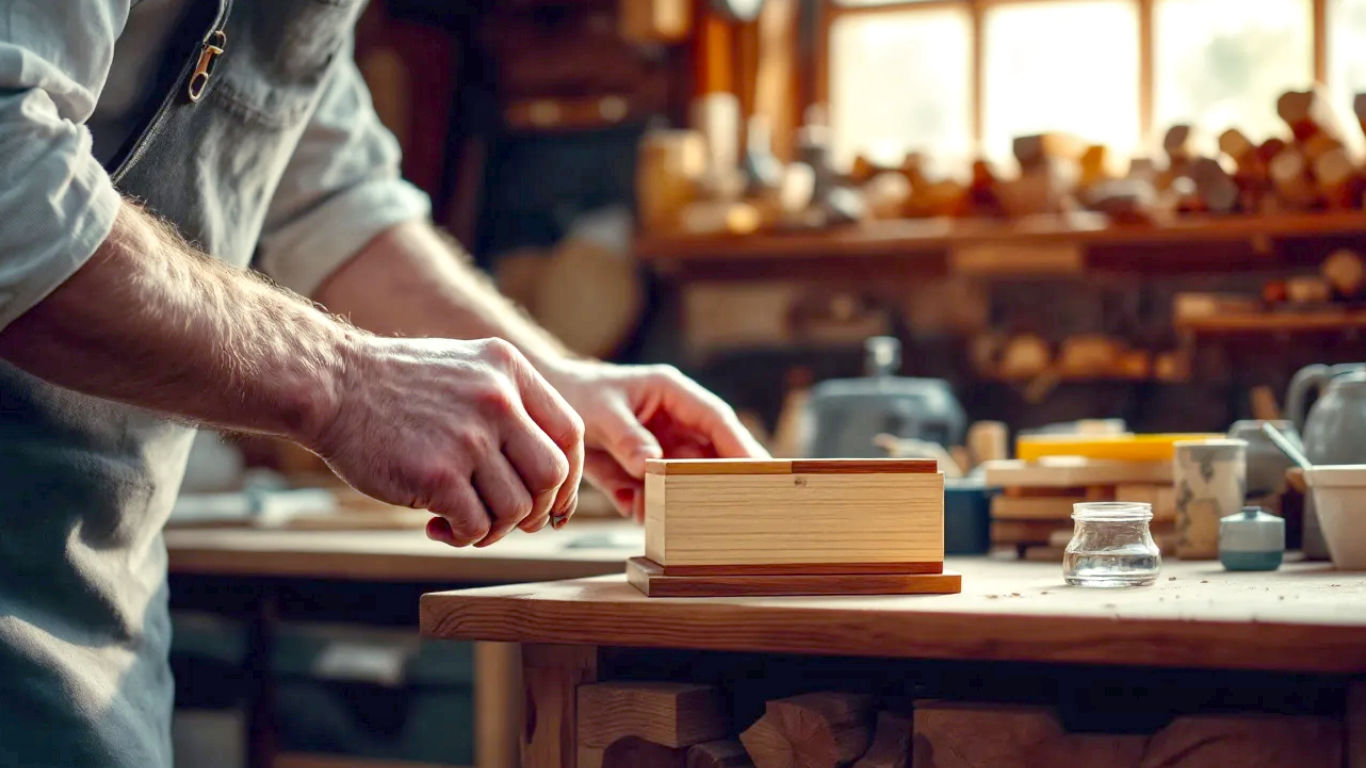Review of ‘Woodworking from Offcuts’ by Derek Jones: From Scrap Pile to Centrepiece?
A deep dive into ‘Woodworking from Offcuts’. We review the 20 projects, the skills it teaches, and whether this book can turn your scrap wood into treasure.

This post may contain affiliate links. If you make a purchase through these links, we may earn a commission at no additional cost to you.
Let’s be honest. If you’ve spent any time in a workshop, garage, or shed, you know about The Pile. It starts innocently enough. A small piece of oak, too nice to burn. The end of a pine board, trimmed to length. A lovely bit of cherry with a fascinating grain pattern, but just a tad too small for the original project. Before you know it, this collection of good intentions has morphed into a precarious, knee-high mountain of timber offcuts.
It’s a universal problem for anyone who works with wood. You can’t bring yourself to throw these pieces away – it feels wasteful, almost disrespectful to the tree they came from. But you don’t know what to do with them either. So they sit there, gathering dust and guilt.
Every now and then, a book comes along that doesn’t just give you a few ideas, but promises a whole new way of looking at this problem. ‘Woodworking from Offcuts: 20 Projects to Create from the Scrap Pile’ by Derek Jones is one of those books. It lands on your doormat with a reassuring thud and a bold claim: that your scrap pile isn’t rubbish, it’s a treasure chest.
Skill Level: Caters to a wide range of woodworking abilities, with projects suitable for various skill levels.
Project Variety: Includes a diverse range of projects, from simple items like a serving platter to more complex ones like a bird box.
Clear Instructions: Each project is explained with clear, straightforward, step-by-step photos and instructions.
Essential Guidance: Includes a guide to the tools, materials, and basic techniques required for the projects.
But does it deliver? Is this the book that will finally help you conquer that timber mountain, or is it just another collection of unrealistic projects destined to make you feel even more guilty? We’re going to take a deep dive into its pages to find out. This is the definitive review for any British woodworker, from the absolute beginner to the seasoned hobbyist, who’s ever looked at a small piece of wood and thought, “There must be something I can make with that.”
Who is Derek Jones? Meeting the Man Behind the Book
Before we get into the nuts and bolts (or rather, the tenons and mortises), it’s worth knowing who’s giving the advice. In woodworking, experience counts for everything, and you want to know you’re in safe hands.
Derek Jones isn’t just some random bloke who’s good with a saw. For many in the British woodworking community, he’s a familiar and respected name. He’s the editor of one of the UK’s leading magazines on the craft, Furniture & Cabinetmaking. This isn’t a fluffy lifestyle publication; it’s a serious journal for people who are passionate about making beautiful things from wood.
Being the editor means he’s seen it all. He’s been exposed to the work of the world’s finest craftspeople, he understands the techniques inside and out, and he knows how to explain complex ideas clearly. He’s a professional woodworker and a writer, a combination that’s surprisingly rare. This background is crucial because it means the book is written from a place of deep, practical knowledge. He understands the frustrations and the joys of working with wood, and he knows what makes a project both achievable and satisfying.
So, when Derek Jones writes a book about using offcuts, you can be fairly sure it’s not going to be full of flimsy, throwaway ideas. You’re getting advice from someone who lives and breathes this stuff.
First Impressions: More Than Just a Project Book
When you first pick up ‘Woodworking from Offcuts’, you immediately notice it’s a quality production. This isn’t a thin, floppy pamphlet. It’s a handsome hardback book with a clean, modern design. The publisher, Guild of Master Craftsman Publications, is known for its high standards, and it shows.
The Look and Feel
The photography is the first thing that grabs you. It’s superb. The images are crisp, beautifully lit, and genuinely inspiring. They don’t just show the finished projects; they make you want to make them. Each item is presented not just as a piece of woodwork, but as a desirable object you’d be proud to have in your home. This is clever because it instantly elevates the idea of ‘scrap wood’ from something you’d hide away to something you’d show off.
The layout is clean and uncluttered. There’s plenty of white space, which makes the text easy to read, and the instructions are laid out logically alongside clear, step-by-step photos and diagrams. It feels accessible and inviting, not dense and intimidating like some older woodworking manuals can be.
The Philosophy: A Manifesto for Mindful Woodworking
As you flick through the introduction, you realise this book is about more than just projects. Jones is putting forward a powerful idea: that working with offcuts makes you a better woodworker.
He argues that when you have a limited amount of material, you’re forced to be more creative, more precise, and more thoughtful. You can’t just cut another piece if you make a mistake. You have to plan carefully and work accurately. This constraint, he suggests, is a powerful teacher.
There’s also a strong undercurrent of sustainability. In a world where we’re all trying to be less wasteful, the idea of turning potential firewood into beautiful, useful objects is incredibly appealing. It taps into that very British ‘make do and mend’ spirit. The book encourages you to see your scrap pile not as a failure to manage your materials, but as an opportunity for creativity. It’s a shift in mindset that’s genuinely refreshing.
A Look Inside: What to Expect from ‘Woodworking from Offcuts’
Alright, so it looks good and has a nice philosophy. But what’s actually in it? Let’s get to the heart of the matter.
The Structure: A Clear Path from Scrap to Success
The book is thoughtfully structured. It doesn’t just throw you in at the deep end. It begins with a solid section on the fundamentals. This covers:
- Sourcing and Preparing Offcuts: How to look at your pile, identify useful pieces, and get them ready for a project.
- Essential Tools: A realistic look at the tools you’ll need, with a good balance between hand tools and power tools.
This introductory section is vital. It ensures that even a relative beginner has the foundational knowledge to tackle the projects that follow. For the more experienced woodworker, it’s a useful refresher.
The Projects: A Tour of the 20 Creations
The 20 projects are the main event, and they are cleverly chosen to cover a wide range of styles, skills, and uses. They are not just random trinkets; most are genuinely useful or decorative items. We can roughly group them into a few categories.
The ‘Five-Minute Marvels’: Quick and Satisfying Makes
These are the projects you can knock out in an afternoon. They are perfect for using up those really small bits of precious wood and for getting a quick hit of woodworking satisfaction. Think of things like:
- A Spaghetti Gauge: A wonderfully simple but clever kitchen utensil that’s perfect for a beginner.
- A Meat Tenderizer: A great project for practicing shaping wood into a comfortable, functional handle.
- A Serving Platter: A straightforward project that can look incredibly impressive, especially when made from a piece of wood with beautiful grain.
These projects are great for building confidence. They teach basic cutting, shaping, and finishing skills without being overwhelming. You can start one after lunch and have it finished in time for a celebratory cuppa, feeling thoroughly chuffed with yourself.
The ‘Weekend Wonders’: More Involved and Rewarding Builds
This is the next step up. These projects require a bit more time and precision, introducing more complex techniques and joinery. They are the kind of thing you can get stuck into over a weekend. Examples include:
- A Ring Box or Pen Case: Perfect small-box projects for honing your skills in accuracy and getting a tight fit.
- A Picture Frame or Letter Rack: These teach you how to cut accurate joints – a skill that’s useful for countless other projects.
- A Bird Box or Garden Planter: Classic and satisfying builds that let you create something useful for the garden from leftover timber.
These builds are incredibly rewarding. When you finish one, you feel like you’ve really made something substantial. They require more patience, but the end result is a high-quality item that looks far more expensive and complicated than it actually is.
The ‘Head-Scratchers’: Clever Designs and Techniques
Finally, there are a few projects that showcase more advanced techniques or particularly clever uses of small pieces of wood. These will challenge the intermediate woodworker and provide some new ideas for the old hands. You might find projects like:
- A Sliding Dovetail Box: A step up from a simple box, this project introduces a strong and elegant joint that requires precision.
- Japanese Work Trestles: A surprisingly sturdy and useful workshop accessory made from smaller pieces, requiring accurate joinery.
- A Desk Lamp: This combines woodworking with basic electronics, resulting in a stylish and highly functional piece for your home office.
These projects ensure the book has longevity. Once you’ve mastered the simpler makes, there’s still something here to push your skills further.
The Instructions: Are They Easy to Follow?
This is where a project book lives or dies. You can have the most beautiful designs in the world, but if the instructions are confusing, the book is useless.
Happily, this is one of the book’s greatest strengths. Derek Jones’s experience as a writer and editor shines through. The instructions are:
- Clear and Concise: The text is written in plain English, avoiding unnecessary jargon. Each step is explained logically.
- Well-Illustrated: The step-by-step photography is excellent. You can see exactly how things are supposed to look at each stage. This is far better than relying on diagrams alone.
- Accurate Measurements: All dimensions are given in both metric (millimetres) and imperial (inches), which is a thoughtful touch that caters to all British sheds, whether you work in new money or old.
The book feels like you have a calm, knowledgeable friend standing beside you, guiding you through the process. It doesn’t assume you know everything, but it also doesn’t patronise you.
Beyond the Projects: Building Skills, Not Just Stuff
A key takeaway from ‘Woodworking from Offcuts’ is that it’s secretly a skills-based book disguised as a project book. As you work your way through the makes, you’re not just accumulating a collection of wooden objects; you’re accumulating a toolbox of techniques.
Mastering the Basics
The projects are a vehicle for learning the craft. You’ll learn:
- How to accurately mark and cut wood.
- How to create fundamental joints like mitres, rebates, and dovetails.
- How to glue up panels effectively.
- How to shape and sand wood for a perfect finish.
By the time you’ve made a handful of these projects, you’ll have a solid grounding in the core principles of woodworking, which you can then apply to your own designs.
Finishing Touches
The book also places a good emphasis on finishing – the final step that can make or break a project. It covers applying oils and waxes, which are perfect for small items as they are easy to apply and bring out the natural beauty of the wood. This is often an afterthought in project books, so its inclusion here is a big plus.
Who Should Buy This Book? Finding the Right Audience
So, who is this book really for? Let’s break it down.
The Complete Beginner
If you have never picked up a saw in your life, you might find some of the projects a little challenging to start with. The book does have a good introductory section, but it assumes a certain level of basic competence and access to a few tools. An absolute novice might be better off starting with a book that focuses purely on the most basic skills before moving on to this one.
The Hobbyist with Some Experience
This is the sweet spot. If you’ve made a few things before, maybe a shelf or a simple box, and you’re looking to improve your skills and get more creative, this book is perfect for you. It will introduce you to new techniques in a manageable way and give you a huge amount of inspiration. It’s the ideal second or third woodworking book for your collection. You’ll find the projects challenging but achievable, and they’ll definitely make you a better woodworker.
The Seasoned Professional
A professional furniture maker probably won’t learn many new core techniques here. However, they will find a wealth of inspiration for using up the valuable hardwood offcuts that litter their workshops. The projects are stylish enough to be potentially sellable at craft fairs, offering a great way to turn waste material into profit. The book’s design philosophy might also spark new creative ideas.
The Verdict: Is ‘Woodworking from Offcuts’ Worth a Spot on Your Shelf?
After spending a lot of time with this book, the answer is a resounding yes. It succeeds on almost every level. It’s practical, inspirational, and beautifully produced. It delivers on its promise to help you see your scrap pile as a resource, not a problem.
The Good Bits (The Pros)
The Niggles (The Cons)
No book is perfect, and if we’re being picky, there are a couple of small points to consider.
How It Compares to Other Woodworking Books
In a crowded market, ‘Woodworking from Offcuts’ stands out. Many project books are filled with dated, clunky designs. The projects here are contemporary and tasteful. Compared to skills-focused books, like those by the legendary Paul Sellers, it’s less about the deep theory of hand tools and more about the satisfaction of creating a finished object. It finds a perfect middle ground between being a practical manual and an inspiring coffee-table book.
Conclusion: The Hidden Treasure in Your Workshop
‘Woodworking from Offcuts’ is more than a book. It’s a solution. It’s the answer to that nagging question of what to do with that pile of wood in the corner of your shed. It reframes the problem, turning waste into opportunity and limitations into a source of creativity.
Derek Jones has created a book that is both aspirational and achievable. It empowers you to create beautiful, functional objects that have a story. They aren’t just things you made; they are things you saved from the fire, giving them a second life.
If you’re a woodworker who wants to reduce waste, improve your skills, and create things you can be truly proud of, you should absolutely buy this book. It will pay for itself the first time you turn a piece of scrap you were about to burn into a gift for a friend. It will transform your relationship with your offcut pile, helping you to finally see it for what it is: not a pile of rubbish, but a pile of possibilities.
Further Reading & Resources
For those looking to dive deeper into the world of British woodworking, here are some highly respected resources:
- Furniture & Cabinetmaking Magazine: The very magazine Derek Jones edits. A fantastic source for high-end projects and techniques.
- Paul Sellers’ Woodworking Blog: A master of hand-tool woodworking, Paul Sellers offers a wealth of free tutorials and advice on his website and YouTube channel. An invaluable resource for learning core skills.
- Axminster Tools: One of the UK’s largest tool suppliers. Their website is full of resources, guides, and, of course, every tool you could ever dream of.
- General Woodworking (UK Workshop): A friendly online community and forum for British woodworkers of all skill levels to share projects and ask for advice.







